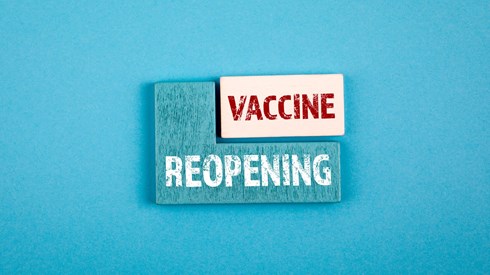An Economic Reopening: The Implications of US Monetary Policy

R. Scott Mildrum | August 23, 2021

Editor's note: This is part 2 of a 4-part series on Captive.com. Part 1 covered the US economic reopening and COVID-19. Part 2 examines US monetary policy as calls for the Federal Reserve to reconsider its highly accommodative policy stance (e.g., bond purchases and near-zero interest rates) have grown significantly louder.
US monetary policy remains ultra-accommodative by historical comparison. The Federal Reserve is purchasing $120 billion worth of bonds every month, has interest rates pinned at virtually zero, and remains committed to the current "inflation is transitory" narrative. Admittedly, the Federal Reserve wants monetary policy to lag this cycle in an effort to further reduce unemployment post-COVID 19, as well as to allow for inflation to run above the 2 percent target rate for a period of time. This represents a different style of monetary policy management than prior Federal Reserve boards. Previously, monetary policy was set with an eye toward the future; this time around, the Federal Reserve wants to achieve specific macroeconomic outcomes before acting. The movement is still the same, however, as the bar for reducing bond purchases is lower than the bar for interest rate hikes; thus, the policy progression is clearly mapped to taper bond purchases and then turn toward interest rate hikes.
The path for tapering bond purchases was laid out at the December 2020 Federal Reserve meeting. Since then, inflation has tracked well above the Federal Reserve's 2 percent target and the US economy has added over 4 million jobs. Despite significant progress from the depths of the COVID-19 recession and further gains since December 2020, the Federal Reserve still believes that inflation can run hot for a while longer and that the unemployment rate has not fallen far enough to warrant a reduction in accommodation.
Barring another COVID-19 setback, it is safe to say we will hear from the Federal Reserve relatively soon regarding the timing of its bond purchase tapering. Federal Reserve Chairman Jerome Powell might use the upcoming Jackson Hole Policy Symposium, a venue of historic importance for monetary policy, to set the stage for any tapering announcement. Then again, a formal announcement might be a few months away as some Federal Reserve officials have been vocal about wanting to see additional employment reports before acting. In fact, in its July policy statement, the Federal Reserve stated that it will monitor progress at upcoming "meetings" (multiple)—not "meeting" (singular)—suggesting to some that the earliest we could see a formal announcement is the November 2021 meeting.
It's important to remember that all this wrangling revolves solely around the Federal Reserve's bond purchase program. The program was an extraordinary measure put in place at the outset of the COVID-19 pandemic when markets were broken and the future was uncertain. We have not even begun to discuss interest rate hikes, which, according to the Federal Reserve's latest Survey of Economic Projections, are not expected until 2023. This all begs the question, Is the current ultra-accommodative policy stance appropriate?
As many policy makers and market participants like to point out, during the last cycle (despite historically easy monetary policy and a labor market that met, if not exceeded, the Federal Reserve's definition of maximum employment) growth and inflation remained relatively subdued. While this statement is undoubtedly true and many of the same macro forces are still in play today, we think it is important to consider just how different this cycle is compared to the last one.
Take, for example, the housing sector. Chart 1 shows the median US home price. The data have been normalized such that the start date equals 100. Here, we compare the Great Recession to the current cycle. Coming out of the Great Recession, it took the median home price more than 65 months to recover to pre-recession levels, whereas this cycle has been a one-way train to the moon. In other words, this time around, homes have been a source of wealth creation, not destruction.
Next, let's look at the labor market. While we have not returned to pre-pandemic levels of employment, it is not for a lack of demand. Chart 2 shows US job openings. Again, the data have been normalized such that the start date equals 100. Here, we again compare the Great Recession to the current cycle. Coming out of the Great Recession, it took over 75 months for job openings to return to pre-recession levels. In the current cycle, it's taken just over a year, with job openings reaching a new record high in June of 2021. There are a few factors restraining labor supply, but one thing is clear: demand is not the problem.
Another closely watched economic indicator is retail sales, and this is where chart 3 tells a similar story. In the wake of the Great Recession, retail sales took over 3 years to recover to pre-recession levels. In contrast, during the current cycle, it took less than a year to recover. Retail sales data clearly show that demand was supported by fiscal policy as direct transfers acted as a substitute for lost income (or additional income for those fortunate enough to keep their jobs throughout the pandemic)—a profoundly different narrative than the one that emerged last cycle.
In chart 4, we highlight the S&P 500, which has doubled since the pandemic lows in March 2020. Highly accommodative monetary policy worked to stabilize financial markets at the start of the pandemic and, given today's low yield environment, has encouraged additional risk taking. After the Great Recession, it took the S&P 500 over 4 years to return to the pre-recession level. In contrast, during the current cycle, it took less than a year to break even, and the gains since have been spectacular (see chart 4).
Finally, it is hard to overstate just how different fiscal policy has been this time around. The response at the outset of the pandemic was both swift and aggressive. The subsequent legislation in late 2020 and early 2021 was equally forceful. At present, rather than talking about sequestration, a bipartisan infrastructure bill has cleared the Senate and Senate Democrats have recently approved a $3.5 trillion budget resolution. Spending upon spending upon spending was not the response we saw last cycle.
The point being that we do not know with certainty if we are destined for different macroeconomic outcomes this cycle or not; nobody does. However, the risk, and the risk alone, that dynamics might play out differently this cycle should at least be acknowledged by policy makers and market participants. With economic activity set to slow from unsustainable reopening levels, 10-year US Treasury yields at 1.36 percent, equity markets near all-time highs, and monetary policy settings tuned to ultra-easy, it is hard to believe any risk is being considered at all. The Federal Reserve's taper is long overdue, and it is not clear to us that Blue Origin can shuttle all financial assets to the moon.
About Performa
Performa has been managing assets on behalf of captive and other insurance clients for more than 25 years. Its capabilities include asset allocation, active fixed income, and equity management through diversified mutual funds and separate account portfolios. With offices in the world's largest captive domiciles, including Bermuda, Vermont, and South Carolina, Performa is 100 percent employee-owned and has $5.30 billion in captive assets under management and advisement as of June 30, 2021.
Disclosures
This article is provided for general informational purposes only. The information compiled is from sources deemed to be reliable, but Performa does not warrant its completeness or accuracy. Opinions, estimates, and assumptions expressed herein reflect our judgment as of the date of publication and are subject to change without notice. This material should not be construed as formal investment or financial planning advice nor as a solicitation to purchase or sell specific securities or investment strategies. Investors should always seek professional financial advice regarding the appropriateness of investing in any investment strategy or security, whether discussed here, or otherwise. This material must not be distributed to any third party without prior written consent.
Any statements regarding performance may not be realized, and past performance is not indicative of future results. Investors should note that the value of any investment strategy or security may fluctuate and underlying principal values may rise or fall.
Performa includes P.R.P. Performa Ltd. and its US affiliate, Performa Limited (US), LLC. P.R.P. Performa Ltd. is licensed to conduct investment business by the Bermuda Monetary Authority (BMA). Performa Limited (US), LLC is a Securities and Exchange Commission (SEC) registered investment adviser. This registration does not imply that the SEC or BMA has approved or disapproved of Performa's services, products, or strategies.
R. Scott Mildrum | August 23, 2021




